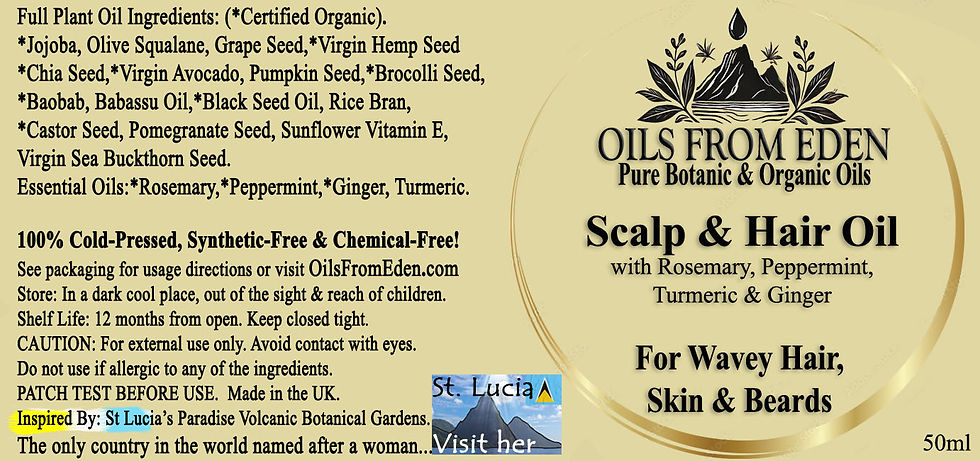Exploring the Benefits of Occlusive and Emollient Oils in Skincare
- garryherbert
- Nov 4, 2024
- 4 min read
Updated: Nov 5, 2024
When it comes to achieving naturally radiant skin, understanding the roles of occlusive and emollient oils can be a game-changer. Both types of oils play unique roles in skincare, addressing different needs in maintaining moisture, texture, and overall skin health. At Oils from Eden, we’re all about harnessing the natural power of oils for effective and gentle skincare solutions. So, let's dive into the specifics of these two types of oils, how they work, and how to incorporate them into your routine for maximum benefit.
What Are Emollient Oils?
Emollient oils are rich, hydrating oils that help soften and smooth the skin by filling in the spaces between skin cells. Think of them as moisturizers that support your skin’s lipid barrier, making it feel soft, smooth, and nourished. Emollient oils work at a deeper level by absorbing into the skin and providing essential nutrients, antioxidants, and fatty acids that support cell repair and resilience.
Popular Emollient Oils
Jojoba Oil – Rich in vitamins E and B, jojoba oil mimics skin’s natural sebum and is excellent for balancing moisture without clogging pores.
Argan Oil – Known for its high vitamin E and fatty acid content, argan oil provides skin with deep hydration and anti-aging benefits.
Camellia Seed Oil – Lightweight yet deeply hydrating, camellia seed oil is loaded with oleic acid and ideal for dry or mature skin.
Apricot Kernel Oil – This gentle, nutrient-rich oil is known for its softening properties and works well for sensitive or dry skin types.
Emollients are essential in formulations focused on hydration, particularly for dry or aging skin. They offer the benefit of a natural glow, improved skin texture, and a supportive environment for skin regeneration.
What Are Occlusive Oils?
Occlusive oils, on the other hand, act as a physical barrier on the skin’s surface, preventing moisture loss by locking hydration in. While they don’t penetrate as deeply as emollient oils, they are crucial for maintaining moisture and protecting the skin against environmental stressors. Occlusives are particularly beneficial for those with very dry or compromised skin that needs extra moisture retention.
Popular Occlusive Oils
Virgin Coconut Oil – A heavier oil that creates a strong barrier, perfect for deeply moisturizing dry skin.
Shea Butter – Although not a liquid oil, shea butter is often used as an occlusive in natural skincare products due to its excellent moisture-locking properties.
Olive Oil – Rich in fatty acids, olive oil sits on top of the skin to help reduce transepidermal water loss (TEWL), while providing antioxidants to protect the skin.
Meadowfoam Seed Oil – With long-chain fatty acids, meadowfoam seed oil forms a protective layer that helps lock in moisture without feeling greasy.
Occlusives are perfect for colder months, when the skin is more prone to dehydration. Applying an occlusive oil as the final step in your skincare routine can help seal in the benefits of all previous products.
Emollient vs. Occlusive Oils: When to Use Which
The choice between occlusive and emollient oils depends on your skin’s needs, your environment, and the specific goals of your skincare routine. Here’s how to decide:
For Dry Skin: Layer both emollient and occlusive oils. Start with an emollient oil to nourish and hydrate, then seal with an occlusive oil to lock in moisture.
For Normal or Combination Skin: Emollient oils are generally enough to keep the skin moisturized without feeling too heavy. Occlusives can be used as needed for extra protection in dry or windy conditions.
For Oily or Acne-Prone Skin: Lightweight emollient oils (such as jojoba or grapeseed) can help balance oil production. Occlusives may not be necessary but can be sparingly applied in areas prone to dryness.
Combining Emollient and Occlusive Oils in Your Skincare Routine
To get the best of both worlds, consider layering your oils. Begin with a lightweight emollient oil after cleansing, which will deliver hydration and nutrients to the skin. Follow up with a small amount of occlusive oil or butter to lock in all that goodness, especially at night when your skin repairs itself.
At Oils from Eden, we love creating blends that combine these oil types to maximize benefits. Our formulations often include oils like apricot kernel, argan, and meadowfoam seed oil to ensure the perfect balance of nourishment and hydration, leaving your skin soft, protected, and radiant.
Choosing the Right Oils for Your Skin
With so many options available, it’s all about finding the right combination for your unique skin needs. Remember, what works for one person may not work for another. When building your skincare routine, consider your skin type, environmental factors, and how your skin responds to different oils.
Embracing a routine that combines both emollient and occlusive oils can give your skin the protection, moisture, and smoothness it deserves. At Oils from Eden, we’re here to help you navigate the world of natural oils with products that are as close to nature as possible, giving you the best in gentle, effective skincare.
Final Thoughts
Understanding how emollient and occlusive oils function allows you to tailor your skincare to the changing needs of your skin and environment. Whether your goal is to combat dryness, soothe sensitive skin, or simply maintain a healthy, glowing complexion, a balanced approach to using these oils can make a noticeable difference.
Explore our collection at Oils from Eden to find your ideal blend and experience the beauty of pure, nature-inspired skincare!




Comments